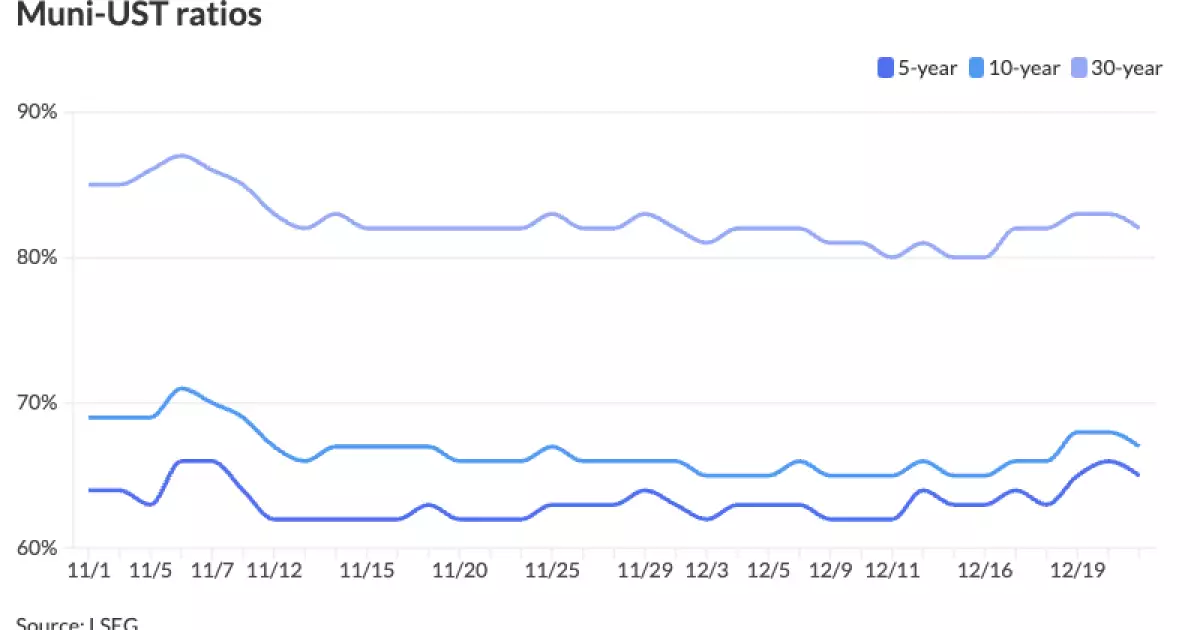The landscape of the municipal bond market has been experiencing significant shifts, particularly in light of recent actions from the U.S. Federal Reserve and evolving economic conditions. Analyzing the current state of municipal bonds reveals insights into the challenges and opportunities faced by investors.
As we approached the holiday season, municipal bonds displayed minimal changes despite a rising trend in U.S. Treasury yields. At the outset of the week, the ratios of two-year, five-year, and ten-year municipal bonds to U.S. Treasuries stood at 64%, 65%, and 67%, respectively. These metrics reflect market movements before the holidays. By the end of the week, there had been a notable increase in yields across different maturity ranges, with the middle segment of the curve experiencing the most significant spikes. Observing these fluctuations provides valuable context for understanding market dynamics and investor behavior.
A critical driver of these changes was Fed Chairman Jerome Powell’s remarks regarding anticipated interest rate policies. Market participants reacted to the projected cautious approach towards rate cuts next year, leading to hikes in municipal yields. This shift resulted in municipal bonds registering a slide over the week, causing previously celebrated gains to evaporate. Indeed, the initially promising returns of 2.88% were trimmed to losses of -1.76%, showcasing the volatility inherent in the bond market.
The increase in yields did not occur in isolation; it consequently affected the ratios between municipal bonds and their Treasury counterparts. For instance, the ratio for two-year municipal bonds climbed notably from 62% to 65.41%. Similarly, the ten-year bonds observed an increase from 66.39% to 69.29%, with long-term bonds overcoming some of their previous lows. The apparent resilience of these ratios may suggest an undervaluing of municipal bonds in response to interest rate pressures.
Moreover, the market’s recent sell-off has made some aspects of municipal securities appear more enticing. Matt Fabian from Municipal Market Analytics implied that yields and prices could attract buyers, despite the upcoming borrowing wave likely to suppress a favorable rally in municipal communities. The larger question remains—will these increases in ratios contribute to a revival in demand for municipal bonds in the near future?
Investor activity has also provided a clearer picture of market sentiment. Recent trends indicated significant outflows from municipal mutual funds—over $857 million—accompanied by a prior week’s outflow of $316 million. Much of this movement can be attributed to seasonal tax-loss harvesting and a broader strategy adjustment as investors maneuver through shifting rate environments. Increased outflows predominantly targeted investment-grade funds, illustrating shifting priorities among bondholders that may indicate a lack of confidence in existing valuations or expected performance.
As J.P. Morgan strategists noted, ongoing dynamics such as declines in UST rates contributed to these shifts, as dealers seemed reluctant to engage aggressively during declining markets—evidenced by the phrase “catching a falling knife.” This reluctance tends to exacerbate volatility, leaving dealers struggling with inventory that has become difficult to offload without incurring substantial losses.
Looking forward, various analysts remain cautious about the implications of rising yields and changing investor behaviors in the municipal bond market. While there are glimmers of interest as conditions shift, the prospect of increased borrowing in the first quarter of the coming year poses a formidable challenge. High supply combined with lingering inflation concerns may create headwinds that limit substantial recoveries in tax-exempt prices.
Additionally, the performance of municipal bonds over longer time spans hinges heavily on macroeconomic factors and investor conviction. Continued mixed signals from equities and Treasury yields complicate the landscape, requiring careful navigation by market participants to optimize returns during uncertain periods.
The municipal bond market stands at a critical juncture reflecting broader economic currents. As investors face mounting complexities driven by external factors, the evolving dynamics of the market necessitate keen observation and strategic adaptations to protect investment interests and capitalize on potential opportunities.

